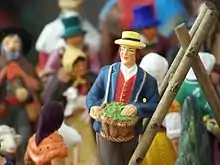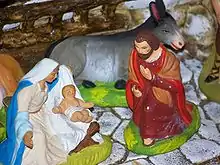Santon (figurine)
Santons (Provençal: "santoun," or "little saint") are small hand-painted terracotta nativity scene figurines[1][2] produced in the Provence region of southeastern France.[1] In a traditional Provençal crèche, there are 55 individual figures representing various characters from Provençal village life such as the scissors grinder, the fishwife, the blind man, and the chestnut seller.[1][2]


The first clay santons were created by Marseillais artisan Lagnel (1761-1822) during the French Revolution when churches were forcibly closed and their large nativity scenes prohibited.[2] Lagnel crafted small figurines in plaster molds and let them dry before firing them.[2]
A maker of "santons" is a santonnier,[2] and the creation of santons today is essentially a family craft, handed down from parents to children.[3] Santons are molded in two halves, pressed together, and fused. Hats, baskets, and other accessories are applied with an adhesive. When the figure is completely dry, it is given a gelatin bath in order to harden the figure further and to provide a surface for the application of pigments.[3] Faces are painted first, then hair, clothing, and accessories. Until the end of the 19th century, santons were air-dried rather than fired in a kiln. As a consequence, such figures were fragile and easily broken because of lack of strength.[3] Modern santons are generally fired in a kiln. There are two types of santons: santons d'argile (clay figures), and doll-like santons habillés (clothed figures).[3]
Since 1803, santonniers have gathered in Marseille each December to display and sell their wares at the Foire des Santonniers.[2] Aubagne Santon Fair in Marseille holds a two-day fair, Biennale de l'Art Santonnier, and the Musée du Santon in Marseille exhibits a private collection of 18th and 19th century santons.[2]
External links
- The Santons of Provence - The official website of France (in English)
- Christmas Cribs and Santons - By Notreprovence.fr (in English)